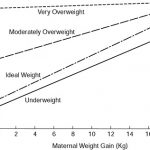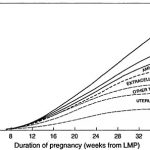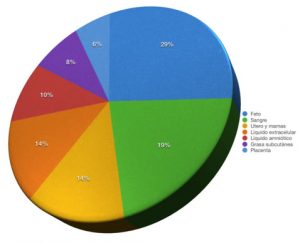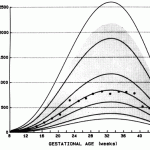- Citas Centro Médico de Caracas: Lunes, Miercoles y Viernes. Pulse el botón Agende una Cita
- Sistema de citas en linea exclusivo para Centro Medico de Caracas en San Bernardino
- Citas CMDLT: Jueves. llamar al 0212-9496243 y 9496245
- Las Emergencias son atendidas en CMDLT previa coordinacion personal al 04142708338
- Proveedor Seguros Mercantil y Sudeban

The increase in maternal weight during pregnancy is a complex process that nourishes the mechanisms that allow the proper growth and development of the fetus, is influenced and modulated by the physiological and metabolic changes of the mother and those induced by the placenta and the fetus.
On average, the average pregnant woman will reach the end of pregnancy with a weight gain of 10 to 16 kilos. Thin, adolescent, and low-weight women tend to gain much more weight (14 to 18 kg.) Than obese patients (4 to 11 kg.); however, this can vary widely depending on the age of the patient, geography, race, pre-pregnancy weight and BMI (Body Mass Index).
In the first 13 weeks of pregnancy you earn around 160 gr. per week (some patients do not gain weight or lose it due to nausea and vomiting); during the second quarter (weeks 14 to 26) the profit is 560 gr. and during the third quarter (weeks 27 to 40) an average of 520 gr. per week The final fetal weight is greatly influenced by the weight gain during the second trimester, so nutrition is very important during this period.
Components of total gestational weight gain
As the pregnancy progresses, nutrients accumulate selectively in the maternal and fetal compartments. The products of conception (fetus, cord, placenta, amniotic fluid, membranes) account for 35% of the total weight gain.
Let’s take a reference case where the increase was 12.5 kilograms, let’s see what elements explain the accumulation of weight, this includes the maternal organism and the fetal elements:
Total water : 7 – 8 kg.
This includes the water that is part of the fetus 2450 gr. (80% of its weight is water, a baby of 3500 gr.), Placenta 540 gr, amniotic fluid 790 g, uterus 800 g, breast 300 g, blood 1250 gr and free water in the tissues (usual swelling and edema) 1500 gr. Water has a very important role in the evolution of pregnancy, this is so true that the increase in total water content is directly related to the final fetal weight at the time of birth.
Fat: 3 – 4 kg.
Body fat (subcutaneous) during pregnancy is deposited differentially in the trunk (abdomen and back) 75%, legs 20% and arms 5%. This pattern of accumulation is exclusive of pregnancy. The deposit occurs in a more sustained manner until week 30. There is also an increase in visceral fat, but its content is difficult to determine. The fat content of the baby is considerably low, around 10%. There is also a very discrete amount of fat in the placenta.
Indeed, despite what is thought, the increase in weight during pregnancy is due more to the accumulation of water than fat, so that in reality the patient does not gain weight in the terms in which we are accustomed to interpret the word fatness This explains why it is relatively easy to lose a few kilograms in a few weeks after birth, most of that weight is water that is lost mainly through urine. But, everything has an exception, patients who gain weight exaggeratedly do so at the expense of body fat accumulating up to 16 kg of subcutaneous fat (or more). In addition, fat has more volume than weight, compared to water, so fat is associated with increased body volume.
Proteins : less than 1 kg (690 grams)
The accumulation of proteins occurs mainly in the fetus (42%), in the uterus (17%), maternal blood (14%), placenta (10%) and breast tissue (8%). As can be seen, the protein contribution in maternal weight gain during pregnancy is very scarce and almost all of it goes to the fetus as a priority, gaining unmatched importance in the formation of fetal organs. Proteins are the most difficult nutritional elements to obtain and there are some amino acids that can only be consumed through the diet since the body is unable to synthesize them (essential amino acids) therefore, a quality diet is extremely important during pregnancy . The balanced and quality diet in pregnancy is becoming the exception in today’s world, and will only worsen in the future for most of the world’s population.
Weight contribution of gestational elements
65% of the total weight is found in the mother and the remaining 35% in the fetal tissues and their auxiliary elements, placenta membranes and amniotic fluid. These percentages refer to the fetus and its membranes at the end of pregnancy
Fetus : 20% of the total weight
As pregnancy progresses, the normal fetus grows uninterrupted from weighing “nothing” until reaching a few kilograms. The final normal weight, at birth, is very difficult to define since there are great personal, family, ethnic and regional variables but it is around 3000 grams. We catalog the normality of the fetal weight, calculated ecographically (and according to pediatric postnatal tables), by means of fetal growth curves based on statistical percentiles:
Suitable for gestational age: the central range, from the 10th percentile (p10) to the 90th percentile (p90)
Small for gestational age (PEG): fetal weight is less than p10
Large for gestational age (GEG): its weight is greater than p90
Birth weight varies depending on when the baby is born, the genetics of the parents, maternal nutrition, placental function, maternal weight gain, water accumulation in their tissues, previous diseases and of obstetric complications of the mother and the fetus. The truth is that in the last 50 years the birth weights have increased due, probably, to the increase in maternal weight and the increased caloric availability in the presence of an increasingly sedentary lifestyle.
As for its composition, 80% of fetal weight is determined by its water content with an average fat content of 12-16% that varies according to its weight at birth: 2500 gr 6 to 14% fat, more than 2500 gr 8 to 20% fat. The fat content in girls is higher than that of boys. Fetal insulin is required to accumulate fat in their deposits and such accumulation is a sign of adequate nutrition in utero. The fetal protein content accounts for approximately 12% of fetal weight.
Placenta: 5% of the total weight
The placenta and the fetus are intimately related as far as their weight and size are concerned, the larger the placenta the greater the final fetal weight. Obese patients (BMI> 30) have larger placentas and usually have heavier fetuses than average-weight women. The size, weight and placental functional capacity increase as the pregnancy progresses and until week 36 and even though it can grow a little more from that point, it does so at the expense of non-functional tissue that will eventually not be able to meet the needs of a growing fetus. This is the reason for not prolonging the pregnancy beyond week 42.
At the end of pregnancy the placenta weighs an average of 500 grams and its weight is determined primarily by water (88%), proteins (11%) and fat (1%).
Amniotic fluid: 10% of the total weight
Amniotic fluid is produced and accumulated through two fundamental sources, fetal urine (90%, 500-700 mL / day) and pulmonary secretions (10%). The control of amniotic fluid volume is achieved by fetal swallowing (200-400 mL / day) and intramembranous absorption (amnion). In the initial stages of pregnancy the productive component predominates over the absorptive so that the volume of liquid increases progressively until reaching its maximum volume in week 33. From this point its volume remains constant for some weeks and finally begin to predominate the absorptive processes on the productive ones and the volume begins to descend from week 38 approximately 125 mL. In week 38, the amniotic fluid has a volume of 1 to 1.2 liters and contributes the total weight of the mother with approximately 1 kilo.
Remember
- Pregnancy is not the excuse, nor does it give you the right, to eat and get fat without any control.
- Being overweight is not the best ally of human reproduction.
- Healthy eating is an art that requires education, practice and will.
- Calories are like sins: easy to acquire but very difficult to eliminate.
- Overweight and obesity are not aesthetic problems, they are personal health problems that have become a real public health problem.
- If you do not consider yourself capable of maintaining an adequate diet during pregnancy, ask for the help of a nutritionist.
- The indulgence in eating only causes overweight: do not abuse the calories.
- Read my article on Obesity and Pregnancy
Weight and gain
Body mass index (BMI): Simple mathematical operation that yields a value that allows you to classify yourself within one of four groups: Low weight, Normal weight, Overweight and Obesity:
BMI calculator
Place your result in one of these four groups and review the weight gain suggested by the Institute of American Medicine:
- BMI <19.8: 12.5 to 18 Kg.
- BMI 19.8-26.0: 11 to 16 Kg.
- BMI 30 – 34.9: 6 to 11 Kg.
- BMI> 30: 5 to 9 Kg.
References:
Weight gain during pregnancy, 2009. Institute of medicine and national research council
Weight gain during pregnancy, 2016. American college of obstetrician gynecologists
From this graph, based on the preconceptional BMI, several conclusions can be drawn:
- The greater the weight (BMI) before pregnancy, the lower the weight gain during pregnancy.
- In women of lower weight, including low degrees of overweight and obesity, the greater the weight gain the greater the birth weight of the baby.
- The greater the pre-conception weight, the greater the birth weight of the baby.
- The problem really arises in low-weight or undernourished maternal populations: if the mothers-to-be do not eat properly or get the extra caloric intake necessary to gain weight, their children will have low weights and probably less cellularity per organ, which is very important if It deals with the brain and its intellectual and cognitive impact.
Weight distribution
*
This graph establishes the components that explain the weight gain divided by areas and systems. The most striking thing is that the big contributors of weight are the fetus, water and total blood. Fat, which one tends to think is the big culprit for weight gain, is almost negligible. Body fat, in this case referential with 11 kg of weight gain constitutes less than 1 kg of the total weight gain.
Volumetric evolution of amniotic fluid during pregnancy:



